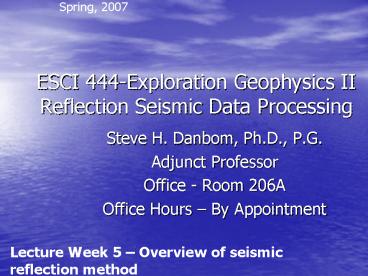ESCI 444Exploration Geophysics II Reflection Seismic Data Processing - PowerPoint PPT Presentation
1 / 43
Title:
ESCI 444Exploration Geophysics II Reflection Seismic Data Processing
Description:
Since we are going to discuss reflection hyperbolae, then a ... Here the analytical time-distance solution for a single reflection ... – PowerPoint PPT presentation
Number of Views:145
Avg rating:3.0/5.0
Title: ESCI 444Exploration Geophysics II Reflection Seismic Data Processing
1
ESCI 444-Exploration Geophysics IIReflection
Seismic Data Processing
Spring, 2007
- Steve H. Danbom, Ph.D., P.G.
- Adjunct Professor
- Office - Room 206A
- Office Hours By Appointment
Lecture Week 5 Overview of seismic reflection
method
2
(T.M. Boyd at CSM)
3
(T.M. Boyd at CSM)
4
(T.M. Boyd at CSM)
5
(T.M. Boyd at CSM)
6
Seismic time-distance curves from the geological
model shown for both reflection and refraction
events.
7
Schematic overview of the convolutional model of
the seismic reflection method.
8
From optics, the concept and use of the source
image.
9
Fermats Least-Time Principle
A light ray traveling from one point to another
will follow a path such that, compared with
nearby paths, the time required is either a
minimum or a maximum or will remain unchanged
(it the ray will remain stationary).
10
Using Fermats Least-Time Principle to prove the
relationship of incident to reflected waves.
11
Since we are going to discuss reflection
hyperbolae, then a review of the analytical
equation for a hyperbola is in order.
12
Here the analytical time-distance solution for a
single reflection event is related back to the
general expression of the hyperbola.
13
Derivation of reflection equation for single
boundary
14
From the theorum of Pathagoris, comes the
expression for normal move out (NMO) for
non-normal incident reflection.
15
Normal Moveout Equation
16
(No Transcript)
17
Derivation of reflection equation for multiple
boundaries
18
Derivation of reflection equation for multiple
boundaries (cont.)
19
Derivation of reflection equation for multiple
boundaries (cont.)
20
For the multi-layered reflection situation, the
problem reduces to a Taylors Series expansion.
21
This summary slide shows that the only item
changing in the definition of the reflection
equation is the definition of Vnmo.
22
Schematic designed to give information on the
sensitivity of normal move out to velocity,
depth, and offset.
23
Display and discussion of field acquisition
geometry
24
(No Transcript)
25
Schematic of the variety of gathers of traces
that we will be discussing with a diagram to
give some indication of their origin.
26
Schematic of the variety of gathers of traces
that we will be discussing with a diagram to
give some indication of their origin.
27
Firstthe trivial for this audience the PP CDP
gather
28
Snells Law for incident P-waves and S-waves
29
The normal moveout equation for mode-converted
shear waves has terms for the compressional and
shear parts.
30
For mode-converted shear waves, the normal
moveout equation has terms associated with both
body-wave velocities.
31
(No Transcript)
32
(No Transcript)
33
(No Transcript)
34
(No Transcript)
35
So nowthe PS CDP gather if you sorted as PP
36
What if you do not make the adjustment?Recall PP
CDP smear in steep-dip areaso, for a first
approximationPS smear fine
37
Some adjustments can be made to the PS processing
38
Here are some more comparisons between PP and PS
39
Because of different NMO and T0 for simple
multiples, they can be identified and
discriminated against in velocity analysis.
40
Arrays of geophones used to cancel
horizontally-traveling noise such as ground
roll, while enhancing deep, vertically- traveling
reflections, can be detrimental to shallow
reflections.
41
Arrays of receiver or source points designed to
eliminate horizontally traveling energy also
attenuate high-frequency content from reflections.
42
Schematics and discussion associated with
discriminating effects of geophone arrays
deployed to reduce surface-wave events.
43
Reference equations and diagrams for refraction
and reflection































